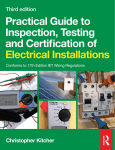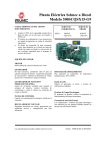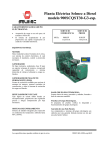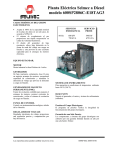Download INSTALLATION & USER MANUAL Domestic
Transcript
INSTALLATION & USER MANUAL Domestic Voltage Optimisation Unit Designed, developed and manufactured in the UK Apex Energy UK St. Johns Road Meadowfield Ind. Est. Durham DH7 8RJ Domestic Voltage Optimisation Unit Table of Contents Introduction................................................................................................................... 3 Purpose ...............................................................................................................................4 Important Points.................................................................................................................4 WARNINGS AND CAUTIONS........................................................................................ 5 Installation ..................................................................................................................... 6 Operation.................................................................................................................... 12 Under Voltage..................................................................................................................12 Over Current.....................................................................................................................12 No Load ............................................................................................................................12 Status Indications .............................................................................................................13 Troubleshooting .......................................................................................................... 15 Technical Specification............................................................................................. 16 Warranty ...................................................................................................................... 16 Document Revision Revision No. Date Reason for revision 1.0 15 June 2006 First issued version June 2012 Page 2 of 16 Domestic Voltage Optimisation Unit Introduction This Installation & User Manual covers the installation and use of the Apex Domestic Voltage Optimisation Unit. The incoming voltage to a property will vary around the country but by law it can be between 216V and 253V, according to current European Legislation ESQCR 2002. However, sudden voltage surges can damage electronic equipment such as computers, washing machine controllers and motion detectors such as passive infrared (PIR). All domestic electrical equipment is designed to work within a range of 207V and 253V if it complies with European Conformity CE But, critically; the optimum and most efficient supply voltage for these appliances is 220V. When the supply voltage exceeds 220V wasted power can be generated, as both heat and vibration; this could significantly reduce the life span and efficiency of the equipment. Household loads that will deliver energy savings are those that are known as “voltage dependent” loads. Appliances that will benefit from Voltage optimisation are typically: Fridge and Freezer motors; Washing machine and dishwasher motors; Garage door motors; Central heating and Gas Boiler pump motors; Vacuum cleaner motors; Kettles; Games consoles; LCD TV’s; Games consoles; Audio systems; Microwave cookers; Incandescent lamps, Compact Fluorescent lamps, Fluorescent tubes, Halogen Lighting Indoor and outdoor. Savings may vary between manufacturers. In addition to energy saving, the Apex VO unit will also protect your appliances from harmful over voltages and spikes that can significantly reduce the electrical life of sensitive electronic equipment. The Voltage Optimiser has a dedicated electronic control unit (ECU) which intelligently and constantly monitors all the parameters, such as incoming and outgoing supply voltage, load, current, temperature, even its own performance, ensuring the unit always delivers the optimum performance to the premises. The voltage optimiser will switch in and out of circuit depending on the algorithm of June 2012 Page 3 of 16 Domestic Voltage Optimisation Unit conditions. It even Incorporates an Internal energy save mode so it is perfectly normal for the unit to be in bypass mode (single green flashing) at certain times. Incorporating the latest sine wave sampling (SWS) and active sine wave mapping (ASWM) technology enables the unit to monitor and control three critical performance and safety functions. Low voltage threshold (LVT) eliminates the risk of the optimised voltage falling below a minimum target voltage. When it detects the voltage has recovered and stabilised it automatically switches back to 'save' mode; High current threshold (HCT) protects against over current. The unit will automatically detect this and remains in a temporary 'bypass' mode until the over current reduces; Optimum switching threshold (OST) by constantly mapping the sine wave, the Voltage Optimiser will only switch at the optimum point, which eliminates any interruption to the supply voltage. It also eliminates spikes and transients. Purpose The purpose of the Voltage Optimiser is as follows: Reduces energy waste and carbon footprint by reducing the power consumed by appliances; Contributes to Government funded targets on carbon reduction; Customer savings start immediately; Substantially extends the life of appliances and lighting; Protects sensitive electrical devices from damage. Important Points Familiarise yourself with this manual and the Voltage Optimiser before installing and operating the unit. In particular, ensure that you have read the WARNINGS AND CAUTIONS section. Contact your electrical supplier before breaking any main fuse seals during the installation of this product. If necessary, ask the supplier to install an isolator switch. June 2012 Page 4 of 16 Domestic Voltage Optimisation Unit WARNINGS AND CAUTIONS These warnings and cautions must be observed when installing/operating the Domestic Voltage Optimisation Unit. WARNING 1 ELECTRICITY CAN KILL. INSTALLING THIS EQUIPMENT WITHOUT ISOLATING THE SUPPLY IS NOT ONLY DANGEROUS BUT CONTRAVENES THE ELECTRICITY AT WORK REGULATIONS 1989. WARNING 2 MAKE SURE THAT MAXIMUM CONDUCTIVE CABLE SURFACE IS IN CONTACT WITH TERMINALS AND THAT THEY ARE SECURE. LOOSE CONNECTIONS CAN CAUSE ARCING THAT MAY RESULTS IN HEAT DAMAGE TO COMPONENTS AND ULTIMATELY FIRE. WARNING 3 THIS WORK MUST BE CARRIED OUT BY A REGISTERED ELECTRICIAN. CAUTIONS June 2012 Do not mount with the transformer lowermost, as heat will rise from it into the unit. Allow a minimum of 100mm clearance around the unit for ventilation. Failure to observe these requirements may result in overheating and possible damage to some of its components. Make sure the installation location is clean and dry, to prevent any current leakage. The unit must never be covered. Page 5 of 16 Domestic Voltage Optimisation Unit Installation The configuration of a typical domestic installation is illustrated in Figure 1. The configuration when integrated with a typical domestic PV installation is illustrated in Figure 2. Figure 1: Typical domestic installation Note: Before commencing with the installation: Make sure that you have the correct thickness and length of tails. Add together the total maximum design current of the circuits to be supplied by the optimiser. Calculate the size of the cable required; refer to Appendix 6 of the BS7671 On Site Guide; Establish how isolation is to be achieved if an isolation switch is not installed; check if there is an isolation facility on the meter. At the last resort, remove the supply fuse, usually a BS88 or BS371 cartridge type. If seals are fitted, notify the supplier and ask permission before you remove them; Make sure the unit is clean and undamaged prior to installation. June 2012 Page 6 of 16 Domestic Voltage Optimisation Unit Figure 2: Typical installation with domestic PV solar power system June 2012 Page 7 of 16 Domestic Voltage Optimisation Unit 1. Remove the cover of the Domestic Voltage Optimisation Unit, which is loosely positioned in the box. The four cover screws will be loosely installed in their locations in the base frame. 2. Record the serial numbers of the main unit and the electronic circuit board on the warranty card that accompanies the unit. 3. Carry out insulation checks between: a. Phase and chassis earth. b. Main Winding and Control Windings. 4. Secure the base to the wall as follows: a. Choose a location for the base unit of the Domestic Voltage Optimisation Unit, either horizontally or vertically on a solid surface in a convenient position for access and in a well-ventilated and dry location. Ensure the unit has a minimum 100mm clearance all around for ventilation. CAUTION If the unit is to be installed vertically, the transformer must be positioned uppermost. b. Measure and mark positions of four or five securing screws, according to whether the unit is to be mounted horizontally or vertically. The dimensions of the hole centres are given in Figure 3 c. Drill appropriate size hole for either direct fixing into wood or the correct type of wall plugs for plasterboard, brick etc. d. Use M8 screws with wall plugs if appropriate. Leave the heads of the screws protruding sufficiently to locate in their relative location holes in the base unit. e. Locate the base unit on the four M8 screws; if necessary, tighten the screws to prevent any movement of the base unit but do not tighten fully, as it should be made possible for the unit to slide in and out of position. Figure 3: Dimensions of mounting hole centres June 2012 Page 8 of 16 Domestic Voltage Optimisation Unit 5. Isolate the supply to the premises at the isolation switch, meter, or by removing the supply fuse as applicable. If the supply fuse is removed, make sure that the fuse holder is covered with insulation material to prevent any possible contact with live terminals. 6. Remove the tails from the consumer unit, and connect directly to the Domestic Voltage Optimisation Unit or, if not if possible due to inconvenient lengths, cut or use new longer tails. If it is necessary to connect longer tails to the meter ask permission before you remove any seals at the meter. If applicable; connect the tails to the meter; make sure that the connection is in accordance with BS7671 Chapter 13 of the Wiring Regulations 17th Edition i.e: That all the terminal screw is in contact with the conductive part of the cable. The positive cable is coloured brown and the neutral blue at terminals. There is no excess conductor exposed. 7. Connect the cable tails from the meter to the Domestic Voltage Optimisation Unit and the output cables as follows: a. If installing with 16mm csa cables cut the grommet. Refer to Figure 4 and Figure 5. If using 25mm csa cables they will be installed in the cut out. Refer to Figure 6. Figure 4: Grommet Preparation for a 16mm csa cable installation June 2012 Page 9 of 16 Domestic Voltage Optimisation Unit Note: Armoured cable can be connected to the base unit by removing grommets and installing glands. b. Connect the cables from the meter to the terminals of the double pole isolator at the Domestic Voltage Optimisation Unit. Connect the output cables from optimiser at the din rail connectors. Refer to Figure 5 for 16mm cable installation, Figure 6 for 25mm cable installation. Figure 5: 16mm csa installation Figure 6: 25mm csa cable installation June 2012 Page 10 of 16 Domestic Voltage Optimisation Unit c. Connect the correct size earth bonding cable (refer to Chapter 4 of the BS7671 On Site Guide) between the main earth terminal and the chassis of the Domestic Voltage Optimisation Unit, using a terminal lug crimped to the earth cable. Note: Leave the main earth conductor (usually 16mm csa) connected between the main earth terminal and the consumer unit. d. Carry out the following dead checks: Continuity of all cables Polarity of the live and neutral. Insulation between phase and earth. e. Carry out the following live checks: Earth Loop Impedance, check it is within limits (max Zs) for the protective devices installed within the Domestic Voltage Optimisation Unit, refer to BS7671 17th edition chapter 4. Prospective fault current if not obtained by enquiry, make sure this does not exceed the breaking current of the unit. Input Voltage Output Voltage. f. Record results obtained in steps d and e on, and include, an installation certificate, refer to Appendix 7 BS7671 OSG. g. If 25mm cable has been used, cut the “notch” in the cover at the cable location. Replace the cover and secure with the four screws; refer to Figure 7. h. Re-instate the supply and turn on the Voltage Optimiser and leave it to go through its self-setting procedure. Figure 7: Cover securing screw locations June 2012 Page 11 of 16 Domestic Voltage Optimisation Unit Operation The Apex Domestic Voltage Optimisation Unit constantly monitors the input supply voltage and current and will automatically control the supply within the parameters of the product. The incoming supply will fluctuate constantly; the Voltage Optimiser will react as follows. A “click” noise may be heard from the unit as it changes state; this is normal. Under Voltage The Incoming supply will fluctuate constantly; where a risk of under voltage exists, the Voltage Optimiser will automatically revert back to mains voltage. Over Current Should the demand exceed the 40A continuous rating of the Voltage Optimiser, the transformer is rated to allow an over current for approximately 30 minutes, after which time if the over current has not returned to its rated level the device will automatically revert to bypass. No Load Where the demand from the Installation falls to a level below 0.5A, typically when the dwelling has no appliances on, the Voltage Optimiser will automatically revert to Ultra Low bypass mode. The operating status of the Voltage Optimiser is indicated by two LED’s in the small circular indicator window. Refer to Figure 8. Figure 8: Optimiser status indicator LED's June 2012 Page 12 of 16 Domestic Voltage Optimisation Unit The Voltage Optimiser will intelligently decide when is the optimum time for it to switch into and out of “ Save Mode” so there is no need to be concerned if the flashing green light is on; it merely Indicates that the total load on the house at that time is not sufficient to warrant the Voltage Optimiser being on. Status Indications The status indicated by the LEDs is described in the following table. A graphical representation of this is given in Figure 9. Green LED Red LED Status Description Constant Off Save Mode The unit is working normally and in Save Mode. Flashing Single Flashing Internal Testing The unit is conducting internal tests (this will typically occur following a power outage). The unit will revert to “Save Mode” once completed. Flashing Off Bypass Mode The unit has reverted to “Ultra Low Bypass Mode” due to the dwelling load being too low to allow any savings to be made. The unit will revert to “Save Mode” when conditions allow. Flashing Single Flashing Bypass Mode The unit has reverted to “Bypass Mode” due to a temporary under voltage. Once the voltage increases to specification levels the unit will automatically revert back to “Save mode”. Flashing Double Flashing Bypass Mode The unit has reverted to “Bypass Mode” due to a temporary over current (60A). Once the current drops below 60A the voltage optimisation device will automatically revert back to “Save Mode”. Flashing Triple Flashing Bypass Mode The unit has reverted to “Bypass Mode” due to a temporary over temperature. Once the unit temperature drops to specification levels the voltage optimisation device will automatically revert back to “Save Mode”. Off Continuous Flashing Unit Shutdown The unit has shutdown either because the Incoming voltage has exceeded 270V OR the Unit has become too hot OR the unit has exceeded its 100A maximum load. Switching the main Isolator off then on again should re set the unit. Please note that there may need to be a time delay before the unit will reset if it tripped due to over temperature. June 2012 Page 13 of 16 Domestic Voltage Optimisation Unit Event Fault Status (RED) RED indicates a fault condition Power up, Self test Start-up Ultra Low Power Bypass mode Number of flashes indicates fault type VO Mode (GREEN) GREEN indicates Voltage selection mode Solid for VO mode Flashing for Bypass Normal Voltage Optimizing mode Low input voltage, Bypass mode High Current, Bypass mode Over Temperature, Bypass mode Unit failure Figure 9: Graphical presentation of status indicators June 2012 Page 14 of 16 Domestic Voltage Optimisation Unit Troubleshooting WARNING 4 ELECTRICITY CAN KILL. TROUBLESHOOTING THIS EQUIPMENT WITHOUT ISOLATING THE SUPPLY IS NOT ONLY DANGEROUS BUT CONTRAVENES THE ELECTRICITY AT WORK REGULATIONS 1989. WARNING 5 TROUBLESHOOTING THAT REQUIRES THE REMOVING OF INSULATING COVERS MUST ONLY BE PERFORMED BY A QUALIFIED ELECTRICIAN. CAUTION Removing the cover of the Domestic Voltage Optimisation Unit without contacting Apex may invalidate your warranty. Loss of Power Consult supplier to check if supply power has been cut. Both LED not lit on Optimiser Check visually cable from meter to optimiser only qualified electricians should carry out further checks or attempt to reconnect cables. Optimiser Unit Failure Contact your Apex supplier Red LED continuously flashing. June 2012 Page 15 of 16 Domestic Voltage Optimisation Unit Technical Specification Incoming Voltage 232V – 253V Outgoing Voltage 214V – 235V Frequency 50 / 60Hz Humidity 85% Ambient Temperature -20 to +30°C Efficiency >98% Insulation Class BS2757 120 degree maximum Cooling Case is ventilated Voltage Surge Able to withstand 3.3kv for 60 seconds Breaking Current 10kA Operating Current Continuous Maximum current = 40A Limited Maximum Current = 60A Maximum By-Pass Current = 100A Dimensions H = 210mm W = 410mm D = 140mm Weight 12kg Designed, developed and manufactured in the UK Warranty The Domestic Voltage Optimisation Unit is guaranteed for one year from the date of purchase. The installer will record the serial numbers of the Voltage Optimiser and the circuit board on the warranty card that you must send to Apex to increase your warranty to three years. Apex Energy UK St. Johns Road Meadowfield Ind. Est. Durham DH7 8RJ June 2012 Page 16 of 16





























